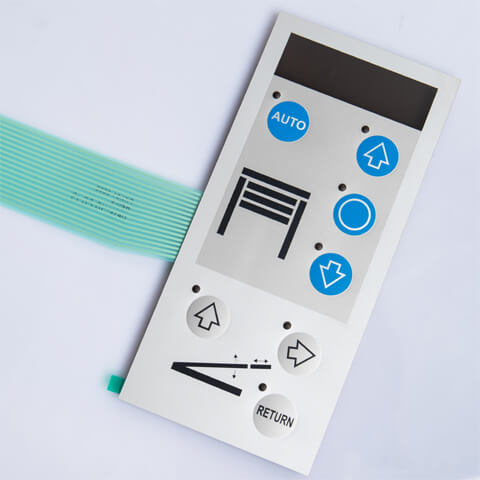How Membrane Layer Changes Add To the Longevity of Electronic Control Panels
Membrane layer buttons play a vital duty in improving the toughness of electronic control panels, mostly via their multi-layered building which provides reliable defense against environmental aspects such as dampness and dirt. The lack of moving parts substantially decreases the probability of mechanical failures, making membrane switches suitable for requiring applications.
Interpretation of Membrane Switches

Membrane layer buttons are created to be slim and lightweight, making them ideal for applications where area is restricted. They can be manufactured in various forms, dimensions, and shades, providing adaptability in design that fulfills visual and practical requirements. Furthermore, membrane layer switches can incorporate various modern technologies, such as responsive feedback and LED signs, boosting customer experience.
As a result of their building, membrane layer switches are typically resistant to dust, wetness, and general wear, adding to their sturdiness popular atmospheres. Their seamless design not just helps with very easy cleaning but likewise reduces the risk of mechanical failing, making them a recommended choice for suppliers looking for trusted individual interfaces in their digital control board.
Security Versus Environmental Aspects
The style of membrane changes inherently supplies a degree of defense versus various ecological aspects, which is important for keeping functionality in challenging problems - Membrane Switch. These switches are commonly created with layers of versatile products that secure inner components from moisture, dust, and impurities. By enveloping the circuitry, membrane changes reduce the threat of brief circuits and rust, which can substantially impair efficiency
Moreover, making use of durable adhesives and sealers throughout production improves their resistance to ecological difficulties. Membrane layer switches can withstand direct exposure to chemicals and solvents, making them suitable for markets such as food processing and healthcare, where health and cleanliness are extremely important. Their smooth surface design also protects against the buildup of dirt and bacteria, facilitating easier cleaning and maintenance.
Temperature fluctuations are one more ecological concern, and membrane layer switches are engineered to function properly throughout a variety of temperature levels (Membrane Switch). This versatility makes sure that control panels remain functional in numerous setups, from commercial settings to consumer electronic devices
Effect On User Interaction
User communication with electronic control board is significantly affected by the design and capability of membrane layer buttons. These buttons give a tactile user interface that boosts the overall individual experience, permitting for intuitive navigating and control. Their receptive nature guarantees that customers obtain instant responses upon activation, which is critical for tasks requiring accuracy and effectiveness.
Furthermore, the smooth surface of membrane switches promotes easy cleaning and upkeep, advertising individual confidence in the reliability of the user interface. This tidiness is specifically crucial in environments where health is paramount, such as clinical or food handling setups. In addition, the compact and lightweight design of membrane layer changes adds to the aesthetic appeal of control board, urging individual interaction through a anchor contemporary and streamlined look.
Moreover, the assimilation of visual elements, such as printed icons and backlighting, aids users promptly identify features, minimizing the finding out curve connected with new devices. As a result, users can operate devices better, bring about raised performance and satisfaction. In summary, membrane buttons play a critical role in improving individual interaction by integrating performance, visual appeals, and simplicity of use, inevitably causing enhanced operational effectiveness.
Design Adaptability and Personalization
Layout adaptability and customization are important aspects of membrane buttons, enabling producers to customize digital control board to details applications and customer requirements. This adaptability allows for the integration of various design aspects, such as shades, graphics, and structures, which can enhance the aesthetic charm and individual engagement of the control panel.
Membrane layer switches can be tailored in shapes and size, fitting a broad variety of devices and applications, from commercial equipment to customer electronics. This flexibility makes sure that producers can develop intuitive user interfaces that straighten with individual expectations and operational demands. Additionally, the ability to integrate one-of-a-kind functions such as backlighting or tactile comments even more enhances functionality, permitting a much more interactive experience.
Moreover, the production procedure for membrane changes sustains the rapid prototyping of styles, allowing manufacturers to iterate and improve their ideas rapidly. This capacity not only increases the growth timeline however also guarantees that the final item fulfills particular practical and aesthetic criteria.

Cost-Effectiveness and Long Life
Cost-effectiveness and longevity are substantial advantages of membrane layer switches, making them an eye-catching choice for producers and end-users alike. These buttons are generally less costly to produce than typical mechanical switches, mainly due to their streamlined manufacturing processes and the reduced variety of components needed. This price benefit extends not only to first production yet likewise to long-lasting functional expenditures, as membrane buttons frequently need less maintenance and have a lower failing rate.
Additionally, the longevity of membrane changes adds to their overall worth. Constructed from resilient products, they are resistant to environmental variables such as wetness, dirt, and chemicals, which can lead to early wear in various other button kinds. The absence of moving components lessens Visit Your URL mechanical failure, allowing membrane switches over to keep performance over extended durations.
This toughness is particularly valuable in visit site applications needing regular performance under requiring problems, such as clinical gadgets and commercial devices. Inevitably, the combination of cost-effectiveness and long life makes membrane changes a financially viable option for suppliers, offering trusted services that hold up against the test of time while enhancing financial factors to consider.
Final Thought
Finally, membrane switches substantially enhance the longevity of digital control board via their durable building and protective features. By properly protecting circuitry from ecological risks and lessening the risk of mechanical failure, these switches make sure regular efficiency sought after applications. The smooth layout advertises health and ease of maintenance, while customization options allow tailored services for different requirements. Generally, membrane changes represent a trustworthy and cost-efficient selection for boosting the long life and performance of electronic control systems.